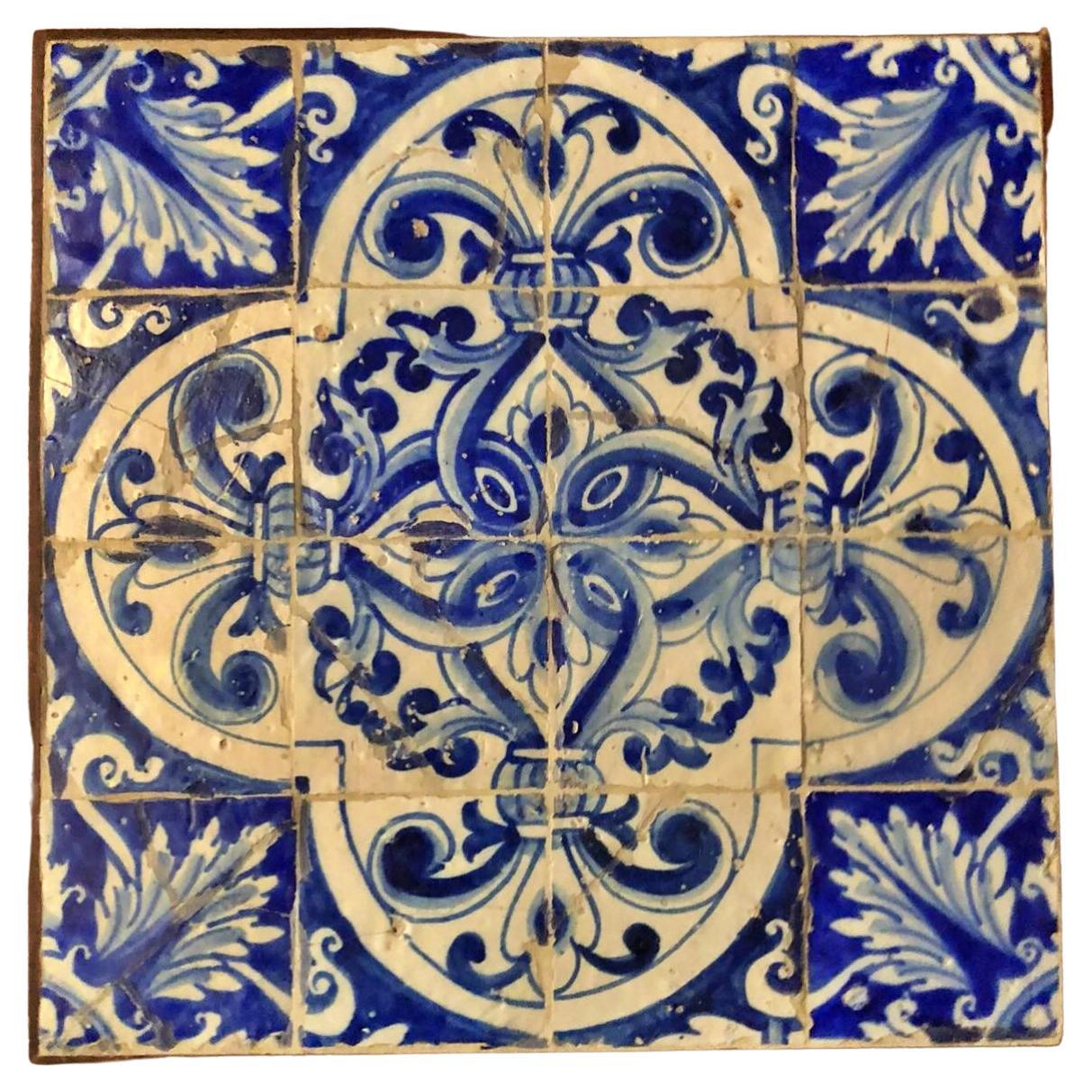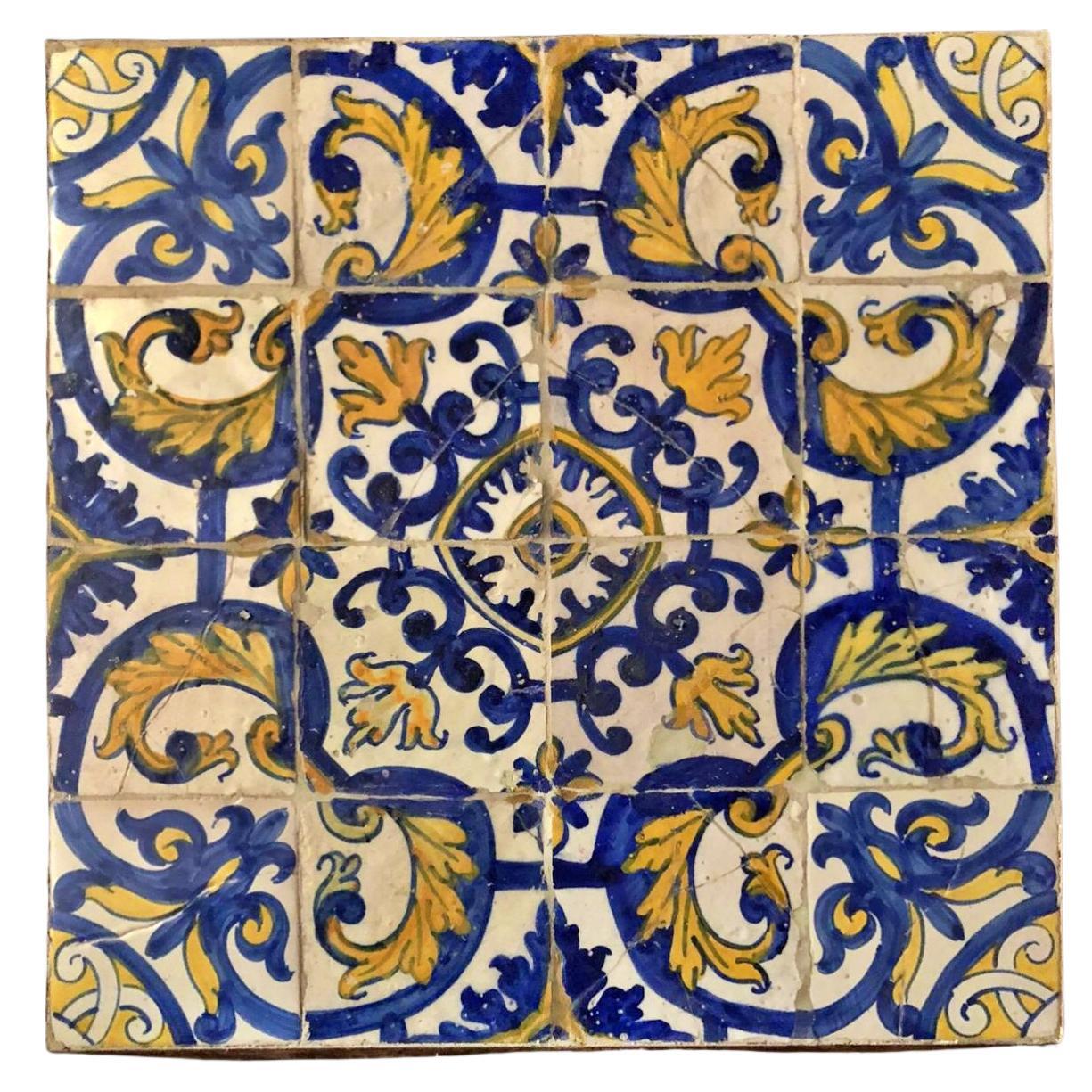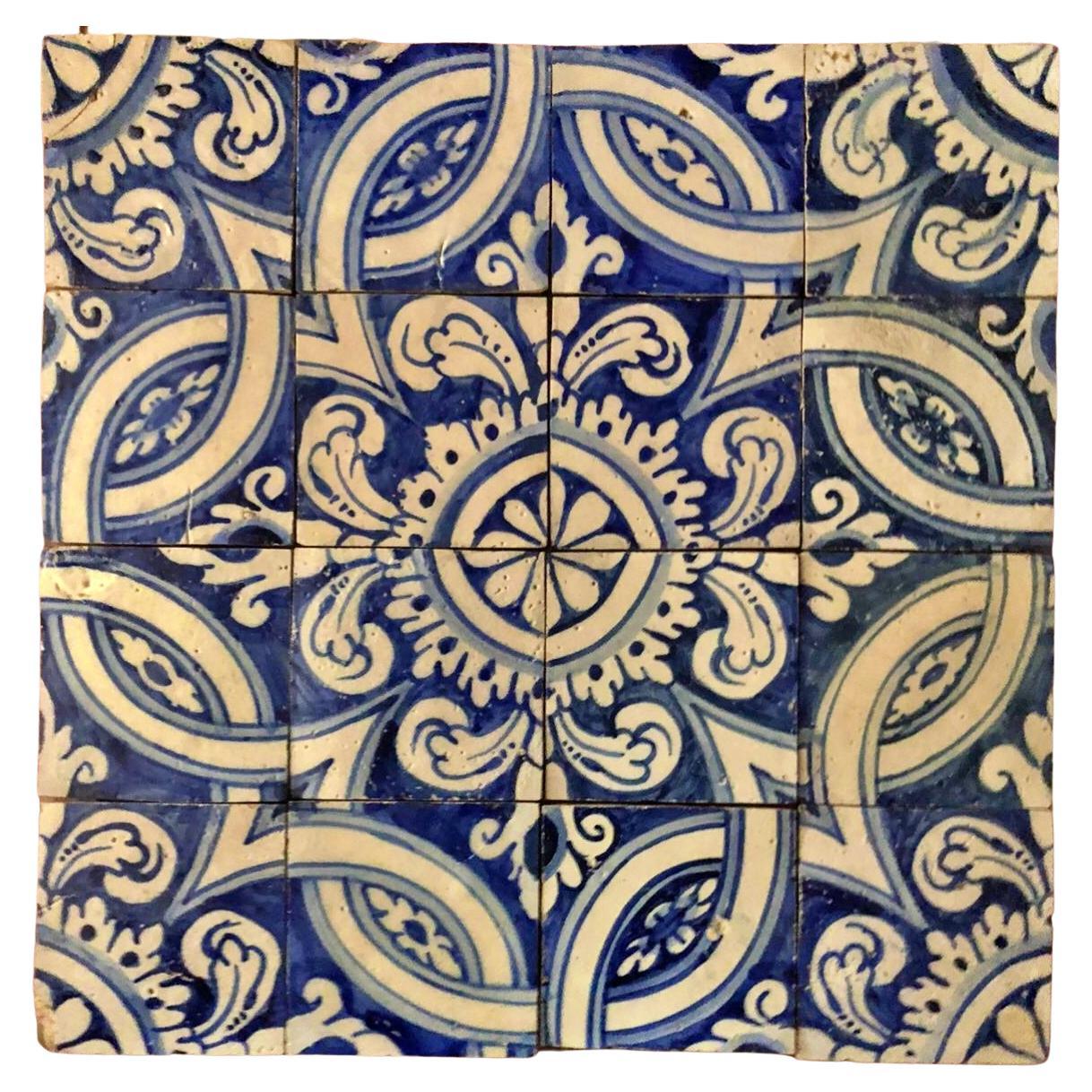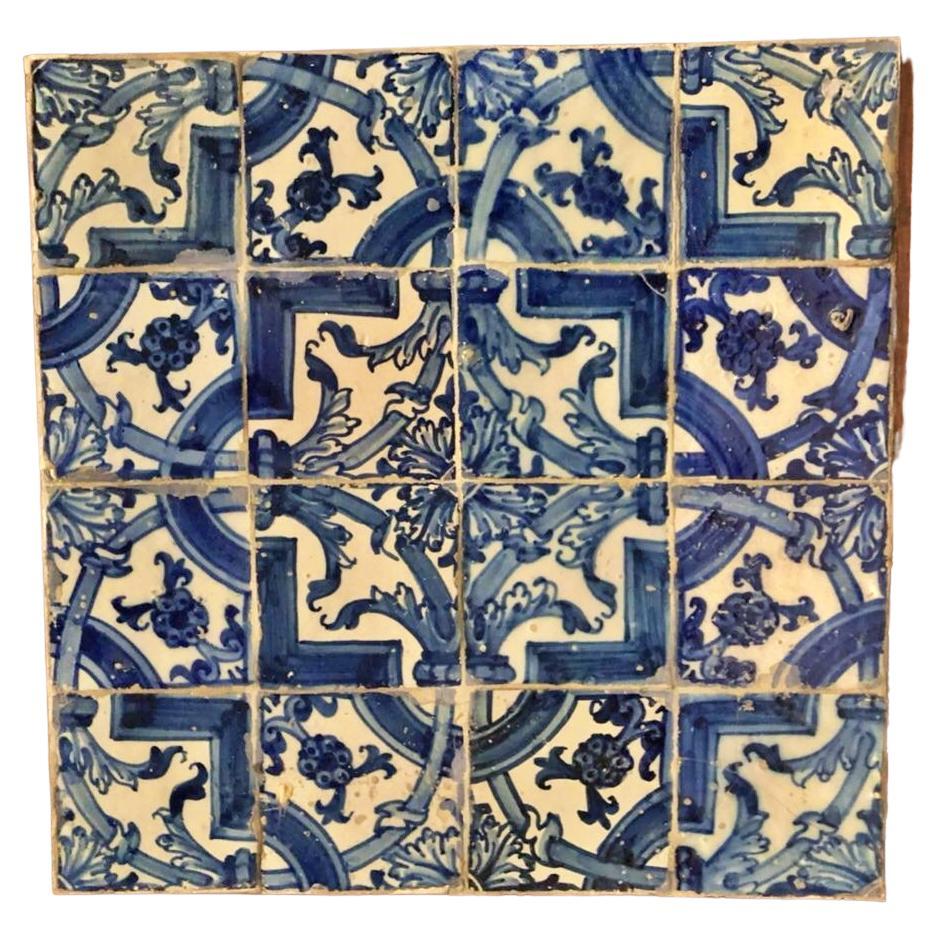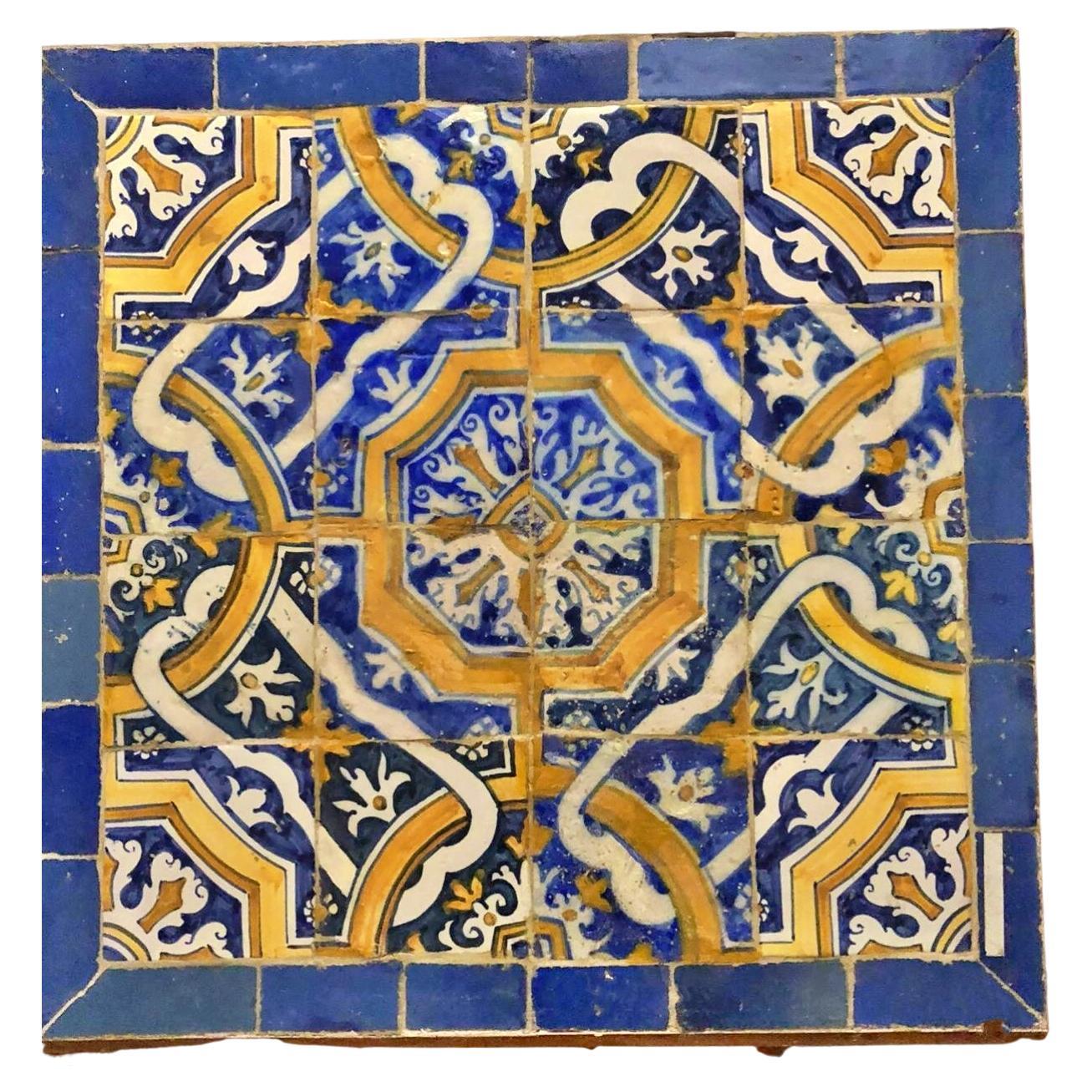Items Similar to 17th Century Portuguese Tile Panel
Want more images or videos?
Request additional images or videos from the seller
1 of 5
17th Century Portuguese Tile Panel
About the Item
17th Century Portuguese Tile Panel.
Restored
56cm x 56cm
14cm x 14cm tiles
With certificate of authenticity and export issued by the Directorate General of Portuguese Cultural Heritage, the only official department for issuing certificates for works of art.
17th Century.
Shortly afterwards, these plain white tiles were replaced by polychrome tiles (enxaquetado rico) often giving a complex framework such as in the Igreja de Santa Maria de Marvila in Santarém, Portugal with one of the most outstanding tile-based interior decorations in Portugal.
When the diagonal tiles were replaced by a repetitive pattern of horizontal polychrome tiles, one could obtain a new design with different motifs, interlacing Mannerist drawings with representations of roses and camellias (sometimes roses and garlands). An inset votive usually depicts a scene from the life of Christ or a saint. These carpet compositions (azulejo de tapete), as they were called, elaborately framed with friezes and borders, were produced in great numbers during the 17th century. The best examples are to be found in the Igreja do Salvador, Évora, Igreja de S. Quintino, Obral de Monte Agraço, Igreja de S. Vicente, Cuba (Portugal) and the university chapel in Coimbra.
The use of azulejos for the decoration of antependia (front of an altar), imitating precious altar cloths, is typical for Portugal. The panel may be in one piece, or composed of two or three sections. They were used in the 16th, 17th and 18th centuries. Some antependia of the 17th century imitate oriental fabrics (calico, chintz). The golden fringes of the altar cloth were imitated by yellow motifs on the painted border tiles. Excellent examples can be found in the Hospital de Santa Marta, Lisbon, or in the Convent of Santa Maria de Almoster and the Convento de Santa Cruz do Buçaco.
During the same period another motif in friezes was introduced: floral vases flanked by birds, dolphins or putti, the so-called albarradas. They were probably inspired by Flemish paintings of flower vases, such as by Jan Brueghel the Elder. These were still free-standing in the 17th century, but they would be used in repetitive modules in the 18th century.
Azulejos dating from 1642 are in the Basilica and Convent de San Francisco de Lima, Peru.
Another type of azulejo composition, called aves e ramagens ('birds and branches'), came into vogue between 1650 and 1680. They were influenced by the representations on printed textiles that were imported from India: Hindu symbols, flowers, animals and birds.
In the second half of the 17th century, the Spanish artist Gabriel del Barco y Minusca introduced into Portugal the blue-and-white tiles from Delft in the Netherlands. The workshops of Jan van Oort and Willem van der Kloet in Amsterdam created large tile panels with historical scenes for their rich Portuguese clients, such as for the Palace of the Marqueses da Fronteira in Benfica, Lisbon. But when King Peter II stopped all imports of azulejos between 1687 and 1698, the workshop of Gabriel del Barco took over the production. The last major production from Holland was delivered in 1715. Soon large, home-made blue-and-white figurative tiles, designed by academically trained Portuguese artists, became the dominant fashion, superseding the former taste for repeated patterns and abstract decoration.
- Creator:Europa Antiques (Artist)
- Dimensions:Height: 22.05 in (56 cm)Width: 22.05 in (56 cm)Depth: 3.15 in (8 cm)
- Style:Baroque (Of the Period)
- Materials and Techniques:
- Place of Origin:
- Period:
- Date of Manufacture:17th Century
- Condition:Repaired. Wear consistent with age and use. restored and cleaning.
- Seller Location:Madrid, ES
- Reference Number:1stDibs: LU5779230454862
About the Seller
4.9
Platinum Seller
These expertly vetted sellers are 1stDibs' most experienced sellers and are rated highest by our customers.
Established in 2005
1stDibs seller since 2021
221 sales on 1stDibs
Typical response time: 1 hour
- ShippingRetrieving quote...Ships From: Madrid, Spain
- Return PolicyA return for this item may be initiated within 14 days of delivery.
More From This SellerView All
- 17th Century Portuguese Tile PanelBy Europa AntiquesLocated in Madrid, ES17th Century Portuguese tile panel. Restored 56cm x 56cm 14cm x 14cm tiles 17th Century Shortly afterwards, these plain white t...Category
Antique 17th Century Portuguese Baroque Decorative Art
MaterialsPorcelain
- 17th century Portuguese Tile PanelBy Europa AntiquesLocated in Madrid, ES17th century Portuguese Tile Panel restored 56cm x 56cm 14cm x 14cm tiles With certificate of authenticity and export issued by the Dir...Category
Antique 17th Century Portuguese Baroque Decorative Art
MaterialsPorcelain
- 17th Century Portuguese Tile PanelBy Europa AntiquesLocated in Madrid, ES17th Century Portuguese Tile Panel Restored 56cm x 56cm 14cm x 14cm tiles With certificate of authenticity and export issued by the Dir...Category
Antique 17th Century Portuguese Baroque Decorative Art
MaterialsPorcelain
- 17th Century Portuguese Tile PanelBy Europa AntiquesLocated in Madrid, ES17th Century Portuguese Tile Panel Restored 56cm x 56cm 14cm x 14cm tiles With certificate of authenticity and export issued by the Dir...Category
Antique 17th Century Portuguese Baroque Decorative Art
MaterialsPorcelain
- 17th Century Portuguese Tile PanelBy Europa AntiquesLocated in Madrid, ES17th century Portuguese Tile Panel Restored Measures: 56cm x 56cm 14cm x 14cm tiles With certificate of authenticity and export issued ...Category
Antique 17th Century Portuguese Baroque Decorative Art
MaterialsPorcelain
- 17th Century Portuguese Tile Panel Representing "The Saints"By Europa AntiquesLocated in Madrid, ES17th Century Portuguese Tile Panel Representing "The Saints" restored 15cm x 29cm Amazing Unique Art Work.Category
Antique 17th Century Portuguese Baroque Religious Items
MaterialsPorcelain
You May Also Like
- XIX Century Portuguese Tile PanelLocated in Lisboa, PTXIX Century Portuguese Altar front Tile Panel with 44 Tiles Altar fronts were rectangular tile panels that covered the part of the altar facing the faithf...Category
Antique Late 19th Century Portuguese Decorative Art
MaterialsClay
- 17th Century Spanish Carved Walnut Door PanelLocated in Stamford, CTA really gutsy and interesting early 17th century carved wood panel. If this kind of thing appeals to you, it does to me, than this is a compelling example of early carving and the p...Category
Antique Early 17th Century Spanish Baroque Decorative Art
MaterialsWalnut
- 17th Century Venetian Embroidery PanelLocated in Atlanta, GAA stunning and monumental 17th century stump work - Embroidery Panel from Venice, Italy. Exquisitely crafted with silks and metallic thread and beading - ho...Category
Antique 17th Century Italian Tapestries
MaterialsMetallic Thread
- Four Kubachi Pottery Tiles, 17th CenturyLocated in London, GBEach tile of square form and decorated in cobalt blue, green, red, mustard yellow and manganese on a white ground with lobed cartouches filled with varied floral motifs and surrounde...Category
Antique 17th Century Asian Decorative Art
MaterialsCeramic
- Framed Antique 17th-Century Dutch Delft Floral Aigrette TileLocated in Pearland, TXA superb antique Dutch Delft hand painted floral aigrette decorative tile in a custom oak frame made in the city of Haarlem, circa 1650. This lovely tile depicts a floral and feather...Category
Antique 17th Century Dutch Decorative Art
MaterialsDelft
- Italian Pietre Dure Panel of Parrot on Branch, Late 17th CenturyLocated in Spencertown, NYThe Pietre Dure panel inset with lapis lazuli, marmo giallo, in a rectangular shape, probably a panel from a cabinet.Category
Antique Late 17th Century Italian Baroque Decorative Art
MaterialsMarble
Recently Viewed
View AllMore Ways To Browse
Wall Panel Blue
17th Century Birds
Three Panel Wall Art
16th Century Panel
17th King
Flemish 16th Century
Oriental Panels
Dutch 17th Century Large
Antique 17th Century Dutch
Jans Antiques
Yellow Wall Panels
Antique Wall Textiles
Baroque Painted Panel
17th Century Spanish Baroque
Spanish Tiles Tiles
Brown University Antique
Dutch 17th Century Flowers
Framed Textile Panel
